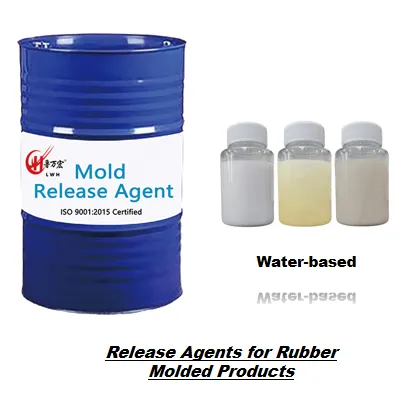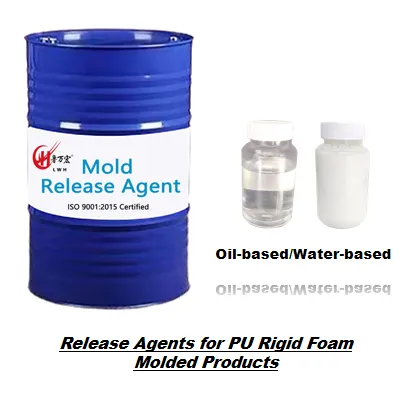เพิ่มประสิทธิภาพของแม่พิมพ์ในอุตสาหกรรมสูงสุดด้วยสารปล่อยขั้นสูง
ภาคอุตสาหการผลิตมุ่งหาทางแก้ปัญหาอย่างต่อเนื่องเพื่อยกระดับประสิทธิภาพการผลิตและคุณภาพของผลิตภัณฑ์ หนึ่งในความก้าวหน้าเหล่านี้ ตัวแทนปล่อย HR PU ได้กลายเป็นทางออกที่เปลี่ยนเกมในแอปพลิเคชันแม่พิมพ์ สารเคมีเฉพาะสูตรนี้ได้ปฏิวัติวิธีการที่ผู้ผลิตจัดการกระบวนการปล่อยแม่พิมพ์ โดยให้ประสิทธิภาพที่เหนือกว่าและผลลัพธ์ที่สม่ำเสมอในหลากหลายการใช้งาน
ในสภาพแวดล้อมการผลิตที่มีการแข่งขันสูงในปัจจุบัน การเลือกตัวปล่อยรูปแบบ (release agent) สามารถส่งผลกระทบอย่างมากต่อทั้งประสิทธิภาพการผลิตและคุณภาพของผลิตภัณฑ์ขั้นสุดท้าย การเข้าใจการทำงานและประโยชน์ของตัวปล่อยรูปแบบ PU HR ถือเป็นสิ่งสำคัญสำหรับผู้ผลิตที่ต้องการเพิ่มประสิทธิภาพในการขึ้นรูป
การเข้าใจเทคโนโลยีตัวปล่อยรูปแบบ PU HR
องค์ประกอบทางเคมีและการแสดงสมบัติ
ตัวปล่อยรูปแบบ PU HR ได้รับการออกแบบด้วยโครงสร้างโมเลกุลเฉพาะตัว ซึ่งสร้างชั้นฟิล์มบางแต่ทนทานระหว่างพื้นผิวแม่พิมพ์กับวัสดุที่ขึ้นรูป สูตรโดยทั่วไปจะประกอบด้วยโพลิเมอร์พิเศษและสารออกฤทธิ์ที่ผิวหน้า ซึ่งทำงานร่วมกันอย่างกลมกลืนเพื่อป้องกันการยึดติด โดยยังคงรักษาความสมบูรณ์ของทั้งแม่พิมพ์และผลิตภัณฑ์สุดท้ายไว้
เคมีขั้นสูงที่อยู่เบื้องหลังตัวปล่อยรูปแบบ PU HR ทำให้มันสามารถสร้างพันธะที่แข็งแรงกับพื้นผิวแม่พิมพ์ ขณะเดียวกันก็ยังคงเฉื่อยต่อสารเคมีของวัสดุที่ขึ้นรูป คุณลักษณะนี้ช่วยให้สามารถปล่อยชิ้นงานออกมาได้อย่างสะอาด โดยไม่กระทบต่อคุณภาพพื้นผิวของผลิตภัณฑ์สำเร็จรูป ผลิตภัณฑ์ .
กลไกการทำงาน
เมื่อทาตัวช่วยปลดล็อก PU HR ลงบนพื้นผิวแม่พิมพ์ จะเกิดเป็นฟิล์มขนาดเล็กจิ๋วที่มีคุณสมบัติในการช่วยปลดล็อกและทนทาน โมเลกุลของตัวช่วยปลดล็อกจะจัดเรียงตัวเองในแนวเฉพาะ โดยปลายที่ส่งเสริมการปลดล็อกจะหันออกด้านนอก การจัดเรียงตัวในระดับโมเลกุลนี้ทำให้มั่นใจได้ว่าวัสดุที่ขึ้นรูปกับแม่พิมพ์จะแยกออกจากกันได้อย่างเหมาะสมที่สุด
เทคโนโลยีที่อยู่เบื้องหลังตัวช่วยปลดล็อก PU HR ยังรวมถึงคุณสมบัติความเสถียรต่อความร้อน ซึ่งช่วยให้ยังคงประสิทธิภาพแม้ในสภาวะการขึ้นรูปที่อุณหภูมิสูง ความต้านทานต่อความร้อนนี้มีความสำคัญอย่างยิ่งต่อการรักษามาตรฐานการทำงานที่สม่ำเสมอตลอดหลายรอบการขึ้นรูป
ประโยชน์ด้านประสิทธิภาพในการผลิต
ประสิทธิภาพการผลิตที่เพิ่มขึ้น
การใช้ตัวช่วยปล่อย PU HR ในการดำเนินกระบวนการผลิตส่งผลให้ประสิทธิภาพการผลิตดีขึ้นอย่างมาก คุณสมบัติการปล่อยชิ้นงานที่เหนือกว่าของตัวช่วยปล่อยช่วยลดระยะเวลาไซเคิลลง เนื่องจากสามารถถอดชิ้นส่วนออกได้อย่างรวดเร็วและสะอาดยิ่งขึ้น ผลสำเร็จนี้ส่งผลโดยตรงต่อการเพิ่มขีดความสามารถในการผลิต และลดต้นทุนการดำเนินงาน
ผู้ผลิตรายงานว่ามีการลดลงอย่างมากในเวลาการทำความสะอาดแม่พิมพ์และความต้องการในการบำรุงรักษาเมื่อใช้ตัวช่วยปล่อย PU HR ความสามารถของตัวช่วยปล่อยในการป้องกันการสะสมและการเกิดคราส่งผลให้ไม่จำเป็นต้องทำความสะอาดแม่พิมพ์บ่อยเท่าเดิม ทำให้เพิ่มเวลาการทำงานเชิงผลิตได้สูงสุด
การปรับปรุงคุณภาพ
คุณภาพของผลิตภัณฑ์มีการปรับปรุงอย่างชัดเจนเมื่อใช้ตัวช่วยปล่อย PU HR คุณสมบัติการปล่อยที่สม่ำเสมอช่วยให้มั่นใจได้ว่าชิ้นส่วนที่ขึ้นรูปแต่ละชิ้นมีความแม่นยำทางมิติและผิวสัมผัสที่คงที่ สิ่งนี้มีความสำคัญอย่างยิ่งในอุตสาหกรรมที่ต้องการความสวยงามและค่าความแม่นยำของมิติอย่างเข้มงวด
สูตรพิเศษที่ไม่เหมือนใครของตัวช่วยปลดหลุดยังช่วยป้องกันข้อบกพร่องผิวทั่วไป เช่น รอยเปื้อน คราบ หรือความเสียหายของผิว ส่งผลให้อัตราผลผลิตชิ้นแรกผ่านเกณฑ์สูงขึ้น และลดของเสีย ซึ่งช่วยเพิ่มประสิทธิภาพการดำเนินงานโดยรวม
วิธีการใช้งานและแนวทางปฏิบัติที่ดีที่สุด
เทคนิคการใช้งานที่เหมาะสมที่สุด
การใช้งานตัวช่วยปลดหลุด PU HR อย่างมีประสิทธิภาพเริ่มต้นจากการเลือกวิธีการทาที่เหมาะสม ควรทาตัวช่วยปลดหลุดเป็นชั้นบางๆ อย่างสม่ำเสมอด้วยอุปกรณ์พ่นหรือเครื่องมือที่เหมาะสม การเคลือบที่ถูกต้องจะช่วยให้ประสิทธิภาพสูงสุด และป้องกันการสูญเสียวัสดุส่วนเกิน
การควบคุมอุณหภูมิระหว่างการทาเป็นสิ่งสำคัญมาก เนื่องจากมีผลต่อความสามารถของตัวช่วยปลดหลุดในการสร้างชั้นปลดหลุดที่มีประสิทธิภาพ ผู้ผลิตควรปฏิบัติตามช่วงอุณหภูมิและสภาพแวดล้อมที่แนะนำเพื่อให้ได้ผลลัพธ์ที่ดีที่สุด
การบํารุงรักษาและการติดตาม
การตรวจสอบสภาพแม่พิมพ์และประสิทธิภาพของตัวช่วยปลดหลุดอย่างสม่ำเสมอ จะช่วยรักษาประสิทธิภาพการผลิตให้อยู่ในระดับสูงสุด การจัดระบบวิธีการทาตัวช่วยปลดหลุดและการบำรุงรักษาแม่พิมพ์อย่างเป็นระบบ จะช่วยให้ผลลัพธ์สม่ำเสมอ และยืดอายุการใช้งานของแม่พิมพ์
การจัดทำเอกสารอ้างอิงพารามิเตอร์การใช้งานและตัวชี้วัดประสิทธิภาพช่วยในการปรับแต่งกระบวนการอย่างแม่นยำ และแก้ไขปัญหาที่อาจเกิดขึ้น การดำเนินการตามแนวทางที่อิงจากข้อมูลนี้ ทำให้สามารถพัฒนาการใช้งานตัวปล่อยรูปแบบต่างๆ ได้อย่างต่อเนื่อง

ความคิดเกี่ยวกับสิ่งแวดล้อมและความปลอดภัย
ผลกระทบต่อสิ่งแวดล้อม
สูตรของตัวปล่อยโพลียูรีเทน เอชอาร์ รุ่นใหม่ถูกออกแบบโดยคำนึงถึงผลกระทบต่อสิ่งแวดล้อมเป็นหลัก ผลิตภัณฑ์จำนวนมากในปัจจุบันมีปริมาณสารอินทรีย์ระเหยง่ายต่ำ (Low VOC) และประกอบด้วยส่วนผสมที่ย่อยสลายได้ทางชีวภาพ ซึ่งสอดคล้องกับแนวคิดด้านความยั่งยืนระดับโลก โดยยังคงรักษาระดับประสิทธิภาพที่ยอดเยี่ยมไว้ได้
ผู้ผลิตสามารถได้รับประโยชน์จากการลดผลกระทบต่อสิ่งแวดล้อม ขณะเดียวกันก็สามารถปฏิบัติตามข้อกำหนดด้านกฎระเบียบ และรักษามาตรฐานการผลิตที่สูงไว้ได้ การพัฒนาตัวปล่อยที่เป็นมิตรต่อสิ่งแวดล้อม ตัวแทนการปล่อย ยังคงมีการพัฒนาอย่างต่อเนื่อง โดยนำเสนอวิธีแก้ปัญหาที่ยั่งยืนมากยิ่งขึ้น
ความปลอดภัยในที่ทำงาน
การพิจารณาด้านความปลอดภัยมีความสำคัญสูงสุดเมื่อทำงานกับตัวปล่อย PU HR สูตรปัจจุบันมีคุณสมบัติที่ช่วยเพิ่มความปลอดภัยในสถานที่ทำงาน เช่น กลิ่นน้อย และลดสารระคายเคืองทางเดินหายใจ ขั้นตอนการปฏิบัติที่ถูกต้องและความต้องการอุปกรณ์ป้องกันจะช่วยให้มั่นใจได้ถึงการใช้งานและการประยุกต์ใช้ที่ปลอดภัย
โปรแกรมการฝึกอบรมสำหรับผู้ปฏิบัติงานและเจ้าหน้าที่บำรุงรักษาควรครอบคลุมการจัดการที่เหมาะสม เทคนิคการใช้งาน และขั้นตอนฉุกเฉิน การดำเนินการด้านความปลอดภัยอย่างครอบคลุมนี้ช่วยป้องกันเหตุการณ์ไม่คาดคิดและทำให้มั่นใจได้ว่าเป็นไปตามข้อกำหนดของกฎระเบียบ
คำถามที่พบบ่อย
ตัวปล่อย PU HR แตกต่างจากตัวปล่อยทั่วไปอย่างไร
ตัวปล่อย PU HR มีเทคโนโลยีโพลิเมอร์ขั้นสูงที่ให้คุณสมบัติการปล่อยที่เหนือกว่า ทนทานยาวนานกว่า และมีเสถียรภาพทางความร้อนที่ดีกว่าเมื่อเทียบกับตัวปล่อยทั่วไป โครงสร้างโมเลกุลที่เป็นเอกลักษณ์ของมันช่วยให้ประสิทธิภาพคงที่ตลอดหลายรอบการใช้งาน ในขณะที่ต้องการการทาซ้ำน้อยลง
ควรทาตัวปล่อย PU HR ใหม่บ่อยเพียงใด
ความถี่ในการทาย้ำขึ้นอยู่กับปัจจัยหลายประการ ได้แก่ เงื่อนไขการขึ้นรูป ประเภทของวัสดุ และปริมาณการผลิต โดยทั่วไปแล้ว สารปล่อยตัว PU HR สามารถใช้งานได้หลายครั้งต่อการทาก่อนต้องทาย้ำอีกครั้ง โดยบางสูตรสามารถใช้งานได้หลายร้อยรอบก่อนต้องทาย้ำ
สามารถใช้สารปล่อยตัว PU HR กับวัสดุแม่พิมพ์ทุกชนิดได้หรือไม่
สารปล่อยตัว PU HR เข้ากันได้กับวัสดุแม่พิมพ์ทั่วไปส่วนใหญ่ เช่น เหล็ก อลูมิเนียม และวัสดุคอมโพสิตต่างๆ อย่างไรก็ตาม สิ่งสำคัญคือต้องตรวจสอบความเข้ากันได้กับวัสดุแม่พิมพ์เฉพาะเจาะจงและเงื่อนไขการใช้งาน โดยอ้างอิงคำแนะนำจากผู้ผลิตหรือการทดสอบ

